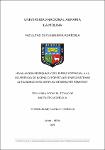Mostrar el registro sencillo del ítem
Evaluación de sequías y del riesgo potencial a la ocurrencia de incendios forestales en ecosistemas altoandinos mediante uso de sensores remotos
| dc.contributor.advisor | Espinoza Villar, Raúl Arnaldo | |
| dc.contributor.advisor | Zubieta Barragán, Ricardo | |
| dc.contributor.author | Ccanchi Espinoza, Yerson Jaime | |
| dc.date.accessioned | 2022-02-03T03:57:54Z | |
| dc.date.available | 2022-02-03T03:57:54Z | |
| dc.date.issued | 2021 | |
| dc.identifier.uri | https://hdl.handle.net/20.500.12996/5195 | |
| dc.description | Universidad Nacional Agraria La Molina. Facultad de Ingeniería Agrícola. Departamento Académico de Ordenamiento Territorial y Construcción | es_PE |
| dc.description.abstract | En las últimas décadas, el registro de la ocurrencia de incendios forestales sobre los ecosistemas naturales se ha incrementado en regiones de los Andes peruanos. No obstante, investigaciones sobre el ambiente favorable al desarrollo de estos eventos, son escasos. Este estudio caracteriza las condiciones climáticas y vegetativas sobre los pastizales andinos, matorrales andinos y bosques naturales de Cajamarca y Cusco, regiones mayormente afectadas por estos eventos durante el periodo 2002-2016. Las variables climáticas de precipitación y temperatura máxima se analizaron utilizando el producto PISCO del SENAMHI. La vegetación se caracterizó a partir de índices de vegetación, para los cuales se utilizaron datos de reflectividad MOD09A1 del sensor MODIS. Se ha identificado que los bajos niveles de humedad y las altas temperaturas propias de las sequías que se presentaron en regiones de la cuenca andina-amazónica, relacionadas a anomalías positivas de temperatura superficial del mar en el Pacífico (durante eventos El Niño) y el Atlántico durante el 2005, 2010 y 2016, tuvieron un alcance en las regiones evaluadas, generando un ambiente favorable para se produzca un incremento severo de incendios forestales. El análisis de la precipitación acumulada, frecuencia de días secos y la frecuencia de días calurosos indican que estos se relacionarían mejor con el desarrollo de los incendios forestales durante el periodo de estiaje e inicio de la temporada de lluvias. A su vez, se identifican umbrales para los índices de vegetación VARI (para Cajamarca) y GVMI (para Cusco) que definen las condiciones vegetativas potenciales para el incremento de incendios forestales en un año normal y con alta ocurrencia. El monitoreo de estos factores climáticos y vegetativos contribuirían a establecer estrategias que conduzcan a la reducción de los impactos negativos que tienen los incendios forestales sobre los ecosistemas altoandinos, los regímenes hidrológicos y la disponibilidad hídrica en el país. | es_PE |
| dc.description.abstract | In recent decades, the record of the occurrence of forest fires on natural ecosystems has increased in regions of the Peruvian Andes. However, research on the environment favorable to the development of these events is scarce. This study characterizes the climatic and vegetative conditions on the Andean grasslands, Andean scrublands and natural forests of Cajamarca and Cusco, regions mostly affected by these events during the 2002-2016 period. The climatic variables of precipitation and maximum temperature were analyzed using the PISCO product from SENAMHI. Vegetation was characterized from vegetation indices, for which MOD09A1 reflectivity data from the MODIS sensor were used. It has been identified that the low humidity levels and the high temperatures typical of the droughts that occurred in regions of the Andean-Amazon basin, related to positive anomalies of sea surface temperature in the Pacific (during El Niño events) and the Atlantic During 2005, 2010 and 2016, they reached the evaluated regions, generating a favorable environment for a severe increase in forest fires. The analysis of accumulated precipitation, frequency of dry days and the frequency of hot days indicate that these would be better related to the development of forest fires during the dry period and the beginning of the rainy season. In turn, thresholds are identified for the vegetation indices VARI (for Cajamarca) and GVMI (for Cusco) that define the potential vegetative conditions for the increase of forest fires in a normal year with high occurrence. The monitoring of these climatic and vegetative factors would contribute to establishing strategies that lead to the reduction of the negative impacts that forest fires have on high Andean ecosystems, hydrological regimes and water availability in the country. | en_US |
| dc.format | application/pdf | en_US |
| dc.language.iso | spa | es_PE |
| dc.publisher | Universidad Nacional Agraria La Molina | es_PE |
| dc.rights | info:eu-repo/semantics/openAccess | en_US |
| dc.rights.uri | https://creativecommons.org/licenses/by-nc-nd/4.0/ | * |
| dc.subject | Sequía | es_PE |
| dc.subject | Incendios forestales | es_PE |
| dc.subject | Recursos hídricos | es_PE |
| dc.subject | Probabilidad de ocurrencia | es_PE |
| dc.subject | Sensores remotos | es_PE |
| dc.subject | Perú | es_PE |
| dc.title | Evaluación de sequías y del riesgo potencial a la ocurrencia de incendios forestales en ecosistemas altoandinos mediante uso de sensores remotos | es_PE |
| dc.type | info:eu-repo/semantics/bachelorThesis | en_US |
| thesis.degree.discipline | Ingeniería Agrícola | es_PE |
| thesis.degree.grantor | Universidad Nacional Agraria La Molina. Facultad de Ingeniería Agrícola | es_PE |
| thesis.degree.name | Ingeniero Agrícola | es_PE |
| dc.subject.ocde | https://purl.org/pe-repo/ocde/ford#1.05.11 | es_PE |
| renati.author.dni | 70894229 | es_PE |
| dc.publisher.country | PE | es_PE |
| dc.type.version | info:eu-repo/semantics/publishedVersion | en_US |
| renati.advisor.orcid | https://orcid.org/0000-0002-1355-9060 | es_PE |
| renati.advisor.orcid | https://orcid.org/0000-0002-4315-7695 | es_PE |
| renati.advisor.dni | 32408522 | es_PE |
| renati.advisor.dni | 41185161 | es_PE |
| renati.type | https://purl.org/pe-repo/renati/type#tesis | es_PE |
| renati.level | https://purl.org/pe-repo/renati/level#tituloProfesional | es_PE |
| renati.discipline | 811096 | es_PE |
| renati.juror | Peña Guillen, Víctor Levingston | |
| renati.juror | Díaz Rimarachín, Jorge Luis | |
| renati.juror | Enciso Gutiérrez, Antonio Celestino |
Ficheros en el ítem
Este ítem aparece en la(s) siguiente(s) colección(ones)
-
IAG-OT Tesis [113]



